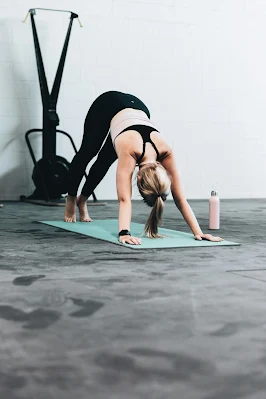Downward-Facing Dog, or Adho Mukha Svanasana in Sanskrit, is one of the most recognizable and frequently practiced poses in yoga. It serves as a cornerstone in many yoga routines due to its versatility, ability to stretch and strengthen multiple muscle groups, and its calming effects on the mind. In this blog, we will explore the intricacies of Downward-Facing Dog, provide a step-by-step guide on how to perform it correctly, and discuss the numerous benefits of incorporating this pose into your practice.
What is Downward-Facing Dog?
Downward-Facing Dog is an inverted V-shaped pose where the body forms a triangle with the floor. The pose involves grounding through the hands and feet while lifting the hips upward, creating a stretch along the spine, hamstrings, and calves. It is often used as a transitional pose, a resting pose, and a strength-building pose, making it an integral part of various yoga sequences.

How to Perform Downward-Facing Dog
Step-by-Step Guide
Start on All Fours: Begin in a tabletop position with your wrists aligned under your shoulders and your knees under your hips. Spread your fingers wide, pressing firmly into the mat.
Engage Your Core: Tuck your toes under and engage your abdominal muscles. This will help protect your lower back and provide stability.
Lift Your Hips: On an exhale, lift your hips up and back, straightening your legs as much as is comfortable. Aim to create an inverted V shape with your body.
Align Your Body:
- Hands: Press evenly through your palms, with your fingers spread wide for support.
- Arms: Keep your arms straight but not locked. Rotate your upper arms outward to broaden your shoulders.
- Back: Lengthen your spine, drawing your navel toward your spine to engage your core further.
- Legs: If your hamstrings are tight, keep a slight bend in your knees. Over time, work towards straightening your legs while maintaining a flat back.
- Feet: Your feet should be hip-width apart, and your heels should reach toward the floor, though they don't need to touch.
Relax Your Neck: Allow your head to hang naturally between your arms, with your gaze directed towards your feet or your navel.
Breathe Deeply: Stay in the pose for 5-10 breaths, focusing on deep, even breathing. With each inhale, lengthen your spine; with each exhale, sink deeper into the stretch.
Release the Pose: To come out of Downward-Facing Dog, lower your knees back to the floor into the tabletop position, or move into a plank pose for further progression in your practice.
Benefits of Downward-Facing Dog
Stretches the Entire Body: This pose stretches the shoulders, hamstrings, calves, and arches of the feet, providing a comprehensive stretch to the entire body.
Strengthens Muscles: Downward-Facing Dog engages and strengthens the arms, shoulders, and legs, building overall body strength.
Improves Circulation: As an inverted pose, it encourages blood flow to the brain, which can help improve concentration and reduce stress.
Energizes and Calms: This pose can be both energizing and calming. It helps relieve fatigue while simultaneously calming the mind and reducing anxiety.
Enhances Flexibility: Regular practice of Downward-Facing Dog increases flexibility in the hamstrings, calves, and shoulders.
Supports Digestion: The gentle inversion can aid in digestion by stimulating the abdominal organs.
Relieves Back Pain: By lengthening and decompressing the spine, Downward-Facing Dog can help alleviate back pain and improve posture.
Tips for Beginners
Use Props: If your hamstrings are tight, place a yoga block under your hands to reduce strain. Alternatively, you can bend your knees to maintain proper alignment.
Focus on Alignment: Prioritize the length of your spine over the straightness of your legs. A flat back is more important than having your heels touch the floor.
Warm Up: Incorporate gentle stretches and warm-up poses before practicing Downward-Facing Dog to prepare your muscles.
Listen to Your Body: Never force your body into a pose. Ease into the stretch and come out of the pose if you feel any pain.
Conclusion
Downward-Facing Dog is a fundamental yoga pose that offers a multitude of benefits for both the body and mind. By incorporating this pose into your yoga routine, you can enhance your flexibility, build strength, improve circulation, and find a sense of calm and balance. Remember to practice with mindfulness and patience, allowing your body to gradually adapt and open up. Whether you are a seasoned yogi or a beginner, Downward-Facing Dog is a pose that will support and enrich your practice.
So, unroll your mat, take a deep breath, and enjoy the transformative power of Downward-Facing Dog. Your body and mind will thank you.